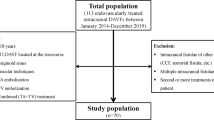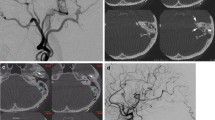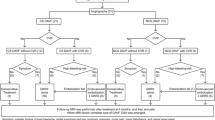Abstract
Purpose
This study aimed to investigate the efficacy and safety of an intraprocedural image fusion technique using flat-panel detector computed tomography-based rotational angiography (FDCT-RA) and image fusion (IF) for the transvenous approach in treating intracranial dural arteriovenous fistulas (dAVFs).
Methods
A retrospective review was conducted on patients who underwent transvenous embolization for dural AVFs. The patients were classified into two groups according to the treatment technique used: the FDCT-RA and IF technique group and the conventional technique group. The primary outcomes assessed were the angiographic and clinical outcomes, complications, fluoroscopy time, and radiation exposure. Univariate analyses were performed to compare the two treatment modalities.
Results
Eighty-six patients with intracranial dAVFs were treated with transvenous embolization (TVE), of which 37 patients underwent transvenous approach with flat-panel detector computed tomography-based rotational angiography (FDCT-RA) and image fusion (IF) technique used. The FDCT-RA and IF group showed difference in the location of dAVFs, occlusion state of the sinus, and access routes in comparison to the conventional treatment group. The FDCT-RA and IF technique was predominantly used for dAVFs involving the anterior condylar confluence and cavernous sinus with ipsilateral inferior petrosal sinus (IPS) occlusion. Patients treated with this technique demonstrated a higher rate of complete occlusion (91.9%, n = 34) compared to those treated with the conventional technique (79.6%, n = 39), but this difference was not statistically significant (p = 0.136). Although the implementation of this technique during the treatment procedure showed a tendency to decrease both fluoroscopy duration and radiation dose, the observed results did not reach statistical significance (p = 0.315, p = 0.130).
Conclusion
The intraprocedural image fusion technique using FDCT-RA for transvenous treatment of intracranial dAVFs could provide help in treatment of dAVFs of certain locations or access routes. It might provide aid in microcatheter navigation, without increasing the radiation exposure and fluoroscopy time.


Similar content being viewed by others
Data availability
Data are available upon reasonable request.
Code availability
Not applicable.
Abbreviations
- FDCT-RA and IF:
-
Flat-panel detector computed tomography-based rotational angiography and image fusion
- TVE:
-
Transvenous embolization
- dAVF:
-
Dural arteriovenous fistula
- IPS:
-
Inferior petrosal sinus
- CRV:
-
Cortical venous reflux
- ICH:
-
Intracranial hemorrhage
- 2D:
-
2-Dimensional
- IJV:
-
Internal jugular vein
- CS:
-
Cavernous sinus
- ACC:
-
Anterior condylar confluence
References
Borden JA, Wu JK, Shucart WA (1995) A proposed classification for spinal and cranial dural arteriovenous fistulous malformations and implications for treatment. J Neurosurg 82:166–179
Brown RD Jr, Wiebers DO, Nichols DA (1994) Intracranial dural arteriovenous fistulae: angiographic predictors of intracranial hemorrhage and clinical outcome in nonsurgical patients. J Neurosurg 81:531–538
Chappell ET, Moure FC, Good MC (2003) Comparison of computed tomographic angiography with digital subtraction angiography in the diagnosis of cerebral aneurysms: a meta-analysis. Neurosurgery 52:624–31; discussion 630
Choi JH, Cho DY, Shin YS et al (2020) Intraprocedural flat panel detector rotational angiography and an image fusion technique for delivery of a microcatheter into the targeted shunt pouch of a dural arteriovenous fistula. AJNR Am J Neuroradiol 41:1876–1878
Choi JH, Jo KI, Kim KH et al (2017) Early rebleeding of intracranial dural arteriovenous fistulas after an intracranial hemorrhage. Acta Neurochir (Wien) 159:1479–1487
Choi JH, Shin YS, Kim BS (2019) Making microguidewire loop facilitates navigation through tortuous or abruptly angulated head and neck veins to access cavernous sinus dural arteriovenous fistulas. World Neurosurg 129:e561–e565
Cognard C, Gobin YP, Pierot L et al (1995) Cerebral dural arteriovenous fistulas: clinical and angiographic correlation with a revised classification of venous drainage. Radiology 194:671–680
Defreyne L, Vanlangenhove P, Vandekerckhove T et al (2000) Transvenous embolization of a dural arteriovenous fistula of the anterior cranial fossa: preliminary results. AJNR Am J Neuroradiol 21:761–765
De Marco JK, Dillon WP, Halback VV et al (1990) Dural arteriovenous fistulas: evaluation with MR imaging. Radiology 175:193–199
Halbach VV, Higashida RT, Hieshima GB et al (1987) Dural fistulas involving the cavernous sinus: results of treatment in 30 patients. Radiology 163:437–442
Halbach VV, Higashida RT, Hieshima GB et al (1989) Transvenous embolization of dural fistulas involving the cavernous sinus. AJNR Am J Neuroradiol 10:377–383
Hirai T, Korogi Y, Ono K et al (2001) Preoperative evaluation of intracranial aneurysms: usefulness of intraarterial 3D CT angiography and conventional angiography with a combined unit–initial experience. Radiology 220:499–505
Hiu T, Kitagawa N, Morikawa M et al (2009) Efficacy of DynaCT digital angiography in the detection of the fistulous point of dural arteriovenous fistulas. AJNR Am J Neuroradiol 30:487–491
Hosoo H, Tsuruta W, Nakai Y et al (2019) The visualization methods of occluded dural sinus for safe transvenous embolization of dural AVFs. World Neurosurg 127:e337–e345
Karygiannis MN, Szatmary Z, Claudino PA et al (2006) Facial vein catheterization for transvenous embolization of the cavernous sinus. Technique and advantages of the direct jugular vein approach - report of three cases. Interv Neuroradiol 12:25–30
Koenigsberg RA (1996) Spontaneous pulsatile tinnitus secondary to a dural malformation not visualized by magnetic resonance angiography. Clin Imaging 20:95–98
Mitsuhashi Y, Nishio A, Kawahara S et al (2007) Morphologic evaluation of the caudal end of the inferior petrosal sinus using 3D rotational venography. AJNR Am J Neuroradiol 28:1179–1184
Ruggieri PM, Masaryk TJ, Ross JS et al (1992) Intracranial magnetic resonance angiography. Cardiovasc Interv Radiol 15:71–81
Söderman M, Pavic L, Edner G et al (2008) Natural history of dural arteriovenous shunts. Stroke 39:1735–1739
Srinivasan VM, Chintalapani G, Duckworth EA et al (2016) Application of 4-dimensional digital subtraction angiography for dural arteriovenous fistulas. World Neurosurg 96:24–30
van Dijk JM, terBrugge KG, Willinsky RA et al (2002) Clinical course of cranial dural arteriovenous fistulas with long-term persistent cortical venous reflux. Stroke 33:1233–1236
Funding
This research was supported by a National Research Foundation of Korea (NRF) grant funded by the Korean Government (MSIT) (No. 2021R1G1A1093281).
Author information
Authors and Affiliations
Contributions
The study’s concept and design involved contributions of all authors. Data collection and analysis were primarily done by SHO and JHC. JHC wrote the initial draft of the manuscript, which was reviewed and commented on by all authors. The final manuscript was read and approved by all authors.
Corresponding author
Ethics declarations
Ethics approval
This retrospective study was approved by the Seoul St. Mary’s Hospital Institutional Review Board (Seoul, South Korea).
Consent to participate
Informed consent was waived due to the study’s retrospective design.
Conflict of interest
The authors declare no competing interests.
Additional information
Publisher's Note
Springer Nature remains neutral with regard to jurisdictional claims in published maps and institutional affiliations.
Rights and permissions
Springer Nature or its licensor (e.g. a society or other partner) holds exclusive rights to this article under a publishing agreement with the author(s) or other rightsholder(s); author self-archiving of the accepted manuscript version of this article is solely governed by the terms of such publishing agreement and applicable law.
About this article
Cite this article
Oh, S.H., Choi, J.H., Kim, B.S. et al. Transvenous embolization along with intraprocedural image fusion technique for complex intracranial dural arteriovenous fistula. Acta Neurochir 165, 3769–3777 (2023). https://doi.org/10.1007/s00701-023-05853-7
Received:
Accepted:
Published:
Issue Date:
DOI: https://doi.org/10.1007/s00701-023-05853-7




